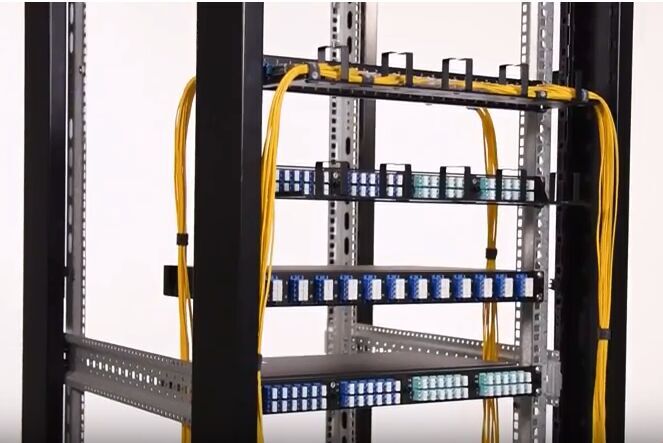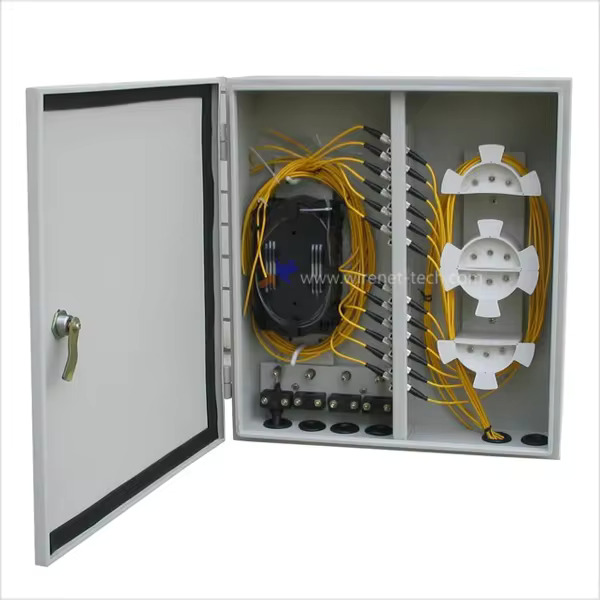What is a Fiber Optic Patch Panel?
A fiber optic patch panel is a passive device used in fiber optic networks to manage and organize fiber optic cables. It typically consists of multiple ports or adapters where fiber optic cables can be terminated, allowing for easy connections and rearrangements of fiber optic links within a network.

How Do Fiber Patch Panels Work?
Fiber patch panels work by providing a centralized location for terminating, splicing, and organizing fiber optic cables. Cables are connected to ports or adapters on the patch panel, which can then be easily interconnected using patch cords. This facilitates the routing of signals between different devices or network segments, allowing for efficient data transmission.
Types of Fiber Patch Panel

Rack-Mount Patch Panels
Installed in standard network racks or enclosures. Suitable to SC LC FC ST or other fiber connectors as requested, Meanwhile, 12, 24, 36, 48, 72, 96, 144 ports are available

Wall-Mount Patch Panels
Mounted directly onto walls for space-saving installations. Suitable to SC LC FC ST or other fiber connectors as requested, Meanwhile, 12, 24, 36, 48, 72, 96, 144 ports are available

Modular Patch Panels
Allow for flexibility in port configuration and expansion. Suitable to SC LC FC ST or other fiber connectors as requested, Meanwhile, 12, 24, 36, 48, 72, 96, 144 ports are available

MPO/MTP Patch Panels
Designed specifically for high-density and multifiber connections. Suitable to SC LC FC ST or other fiber connectors as requested, Meanwhile, 12, 24, 36, 48, 72, 96, 144 ports are available
What is the Use of Fiber Patch Panel?
The primary use of a fiber patch panel is to provide a central location for terminating, splicing, and organizing fiber optic cables in a network. It enables easy management, maintenance, and troubleshooting of fiber optic connections, facilitating efficient data transmission and network performance.
Benefits of Fiber Patch Panels
- All changes are made at one place
Patch panels make it easier to connect different devices in different orders, because all of the changes can be made at the patch panel. - No more hunting for input ports
A patch panel groups all of the input jacks/ports into one location. This means that devices mounted in racks can be connected without having to hunt around behind the rack or instrument with a flashlight for the right port. - Saves wear and tear of expensive networking equipment
Using a patch panel also saves wear and tear on the input ports of expensive networking equipment such as servers and switches, because all of the connections are made with the patch panel.
How to Connect Fiber Optic Cable to Patch Panel?
To connect fiber optic cables to a patch panel:
- Prepare the fiber optic cable ends by stripping the protective jacket and buffer tubes.
- Clean the fiber ends to ensure optimal connectivity.
- Insert the fiber ends into the appropriate ports or adapters on the patch panel.
- Secure the fibers in place using splice trays or connector housings.
- Use patch cords to interconnect the fibers as needed.
You can check the below video for more details
How to Label a Fiber Patch Panel?
To label a fiber patch panel:
- Use clear and legible labels for each port or adapter on the patch panel.
- Label the ports according to their corresponding network devices or locations.
- Include additional information such as port numbers, cable types, or signal types if necessary.
- Ensure that labels are securely attached and easily visible for quick identification.
How to Splice Fiber Pigtails in Fiber Optic Patch Panels?
To splice fiber pigtails in a fiber optic patch panel:
- Strip the protective coating from the fiber pigtails and prepare the fiber ends.
- Clean the fiber ends and cleave them to ensure a clean and flat surface.
- Place the fiber pigtails into splice trays or fusion splice holders within the patch panel.
- Use a fusion splicer to splice the pigtails to the corresponding fibers within the patch panel.
- Secure the spliced fibers and close the splice trays or holders to protect the splices.
How to Choose Fiber Optic Patch Panels for your Projects?
When selecting fiber optic patch panels, consider:
- Port Density: Choose a patch panel with sufficient ports for current and future needs.
- Connector Type: Ensure compatibility with the connectors used in your network.
- Mounting Options: Select rack-mount or wall-mount options based on your installation requirements.
- Construction and Durability: Look for high-quality materials and construction for long-term reliability.
- Additional Features: Consider features such as cable management, labeling options, and compatibility with other network components.
By considering these factors, you can choose the appropriate fiber optic patch panel to meet your network requirements effectively.
Discover Fiber Optic Solution for Your Business with Bativ
Whether you need rack mount or wall mount fiber patch panels, work with an experienced fiber optic connectivity company like Bativ. We can deliver high-quality SC LC ST FC E2000 fiber patch panels and more.
We’ll guide you on the best types of fiber patch panels for your needs and budget. we’re here to help. Get in touch today to discuss your requirements.